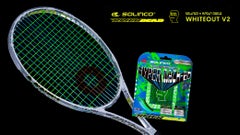What Tennis Strings are Made of - Strings Explained
Tennis strings are available in a few different materials. We explain the differences, how they affect performance, string tension basics and how often you should change your strings.
Why Strings are so Important
Imagine if you could customize the next car you purchase by picking out the engine. You wouldn't just pick any old engine to put in your dream car would you? You'd want to do some research first and figure out which engine fits your needs the best. Not necessarily just the cheapest engine. So you wouldn't spend hundreds on your next racquet and when it comes time to pick out your string, you wouldn't just pick any old string would you? Well, lots of people do. Strings are vital to how a racquet plays and performs. It's the only thing that actually makes contact with the ball. But learning about string and picking the right one can be daunting with the huge variety to choose from. We're here to help. Hopefully this article will provide you a clearer picture about "the engine" in your racquet.
Construction
In other words, what the string is made of. There are four main categories that tennis strings will fall under: synthetic gut, multifilament, natural gut and polyester.
Synthetic Gut
This is the cheapest type of string you can buy. It is typically made of nylon and offers good playability for the price.
UPSIDES |
DOWNSIDES |
| Economically priced | Average overall performance & playability |
| Good all-around choice | Not extraordinary in any category |
Multifilament
Offers playability most similar to natural gut string. They are made from hundreds of tiny fibers wound together. These range in price anywhere from $5 on up to $20.
UPSIDES |
DOWNSIDES |
| Very good playability | Less control oriented |
| Wide range of price points | Certain multifilament can feel "mushy" |
| Softer on the arm | Less durability for bigger hitters |
| Very good tension maintenance | |
| Closest thing to natural gut |
Natural Gut
Made from a cow's intestines, this is the string multifilament strings try to emulate. Natural gut strings hold their tension the best, is the most comfortable on the arm (great for players with arm problems) but is also the most expensive.
UPSIDES |
DOWNSIDES |
| Optimum playability | Most expensive string type |
| Best tension maintenance | |
| Good arm comfort | |
| Remains playable at very high tensions |
Polyester
This string type has taken over the market and the pro tour. This is a stiffer string that offers intermediate to advanced players with faster swing strokes control and spin. We don't typically recommend this type of string for most beginner level players.
UPSIDES |
DOWNSIDES |
| Durable | Low powered |
| Lots of control | Harsher on the arm |
| Lots of spin | Loses tension faster |
Gauge
Gauges are essentially the thickness of a string. The higher the gauge, the thinner the string. The problem with gauges however, is that there is not a standardized and universal chart. A 16 gauge for one company might be a 16L (L stands for "light," which basically means it's halfway between two gauges, think of a 16L as a 16.5) for another. This is why we recommend referencing the actual millimeter sizing. In general, thinner string will provide more power and spin, while thicker strings provide more control and durability.
Tension
Tension is referring to how tightly the strings are strung in the racquet. Each racquet will have a specific tension range that the manufacturer recommends you string within, usually around 50-60 pounds. Even though you can request your racquet to be strung above the maximum tension, it could void the warranty by doing so. In general, the higher the tension, the more control and the lower the tension, the more power. Typically, players sho generate their own power will string with a higher tension and vice versa for a beginner. If you don't know what tension to string with, we recommend you choose the the middle tension and then you can make adjustments from there. Need more power? Go down 2-3 pounds next time.
LEARN MORE: HOW TO CHOOSE STRING TENSION
When to Restring
Contrary to popular belief, breaking a string isn't the only time you should restring your racquet. For the casual recreational player, a good rule of thumb to follow is to restring as many times in a year as you play in a week. For example, if you play 5 times a week, then you should restring at least 5 times a year. But if you use polyester string, we would recommend stringing more often. You might see in some of our string reviews that we mention that the string has "bagged out." That is when a string has lost most of its tension and therefore, lost most of its playability, which includes power, control and feel.








